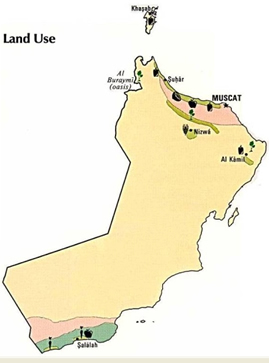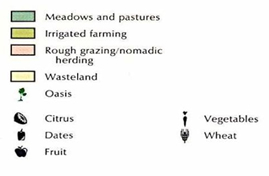Agriculture in Oman is diversely structured
and gives examples for traditional agricultural systems which have been
sustainable over millennia, as well as for ecological and economical effects
of fast and sudden modernization processes.
About 42% of the Omani population are employed in agriculture and fisheries.
They produce about 46% of the food used for human nutrition in Oman, the
rest is imported.
The country’s area includes only 2.2 million hectares of cultivable
land, including arable land, grazing area and forests. For the cultivation
of crops, only 61 550 ha (0.2% of the total area) were used in 1993, and
all this area has to be irrigated (FAO 1997). This number may have risen
since, as there has been a constant increase in irrigated area since 1970.
The most important crop grown is dates (44% of the agricultural area in 2000), followed by 23% vegetables (e.g. tomatoes, potatoes, cabbages), 16% alfalfa, 15% fruit (lemons, mangoes, banana, pomegranate and in Dhofar coconuts) and only 2% wheat and tobacco (FAO 1997).
Distribution of Land Use
Most of the agricultural production is concentrated along the coastal
plains. In these regions, irrigation water is mostly taken from wells,
and a fast process of modernization has taken place since the 1970’s.
In the mountainous region of the north, oases settlements have developed
where water from springs can be used through the aflaj irrigation system,
which has been preserved up to today to a large extent. Some agricultural
production exists in the deserts. fed from millenia old water reservoirs
in great dephts.
To read more, please download the essay "Irrigation
and Salinisation: A Comparison of Traditional and Modern Irrigation Agriculture"
by
Sara Preißel and Moritz Reckling.
Continue to "Irrigation
and Salinisation".
![]() back
to top
back
to top

